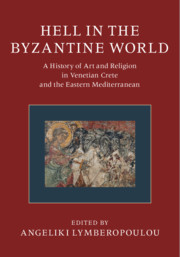 Hell in the Byzantine World
Hell in the Byzantine World Book contents
- Hell in the Byzantine World
- Hell in the Byzantine World
- Copyright page
- Dedication
- Dedication
- Contents
- Figures and Maps
- Preface
- Acknowledgements
- Editorial Policy
- Volume 1
- Introduction
- Part I Crete
- 1 From Crete to Hell
- 2 Venetian Crete
- 3 Hell on Crete
- 4 Hell from West to East
- Part II Eastern Mediterranean
- Volume 2
- Bibliography
- Index
1 - From Crete to Hell
The Textual Tradition on Punishments in the Afterlife and the Writings of Joseph Bryennios on Crete
from Part I - Crete
Published online by Cambridge University Press: 02 October 2021
- Hell in the Byzantine World
- Hell in the Byzantine World
- Copyright page
- Dedication
- Dedication
- Contents
- Figures and Maps
- Preface
- Acknowledgements
- Editorial Policy
- Volume 1
- Introduction
- Part I Crete
- 1 From Crete to Hell
- 2 Venetian Crete
- 3 Hell on Crete
- 4 Hell from West to East
- Part II Eastern Mediterranean
- Volume 2
- Bibliography
- Index
Summary
Dionysios Stathakopoulos’ chapter is divided in two parts. In the first he presents the textual sources that have had a seminal influence on the establishment of a visual vocabulary of transgressions that appear in depictions of Hell in monumental painting. He focuses on the development of ideas of punishment in the afterlife, tracing their origins from the Old and the New Testament and apocryphal texts to late Byzantine theology, which were popular in shaping ideas on punishment. Since, however, they do not always assist our understanding of the iconography of Hell, as this also reflects the social preoccupations of the community that commissioned the cycles, Stathakopoulos, in the second part of his chapter, turns to Joseph Bryennios (born around 1350), who recorded a vivid depiction of his experiences during his appointment on Crete, in an attempt to look into the contemporary society that commissioned the Cretan Hell cycles that lie at the heart of this publication.
Keywords
- Type
- Chapter
- Information
- Hell in the Byzantine WorldA History of Art and Religion in Venetian Crete and the Eastern Mediterranean, pp. 21 - 59Publisher: Cambridge University PressPrint publication year: 2020
- 1
- Cited by
